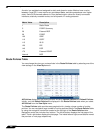
Network > Routing
226
SonicOS Enhanced 4.0 Administrator Guide
Route Advertisement
The SonicWALL security appliance uses RIPv1 or RIPv2 to advertise its static and dynamic
routes to other routers on the network. Changes in the status of VPN tunnels between the
SonicWALL security appliance and remote VPN gateways are also reflected in the RIPv2
advertisements. Choose between RIPv1 or RIPv2 based on your router’s capabilities or
configuration. RIPv1 is an earlier version of the protocol that has fewer features, and it also
sends packets via broadcast instead of multicast. RIPv2 packets are backwards-compatible
and can be accepted by some RIPv1 implementations that provide an option of listening for
multicast packets. The RIPv2 Enabled (broadcast) selection broadcasts packets instead of
multicasting packets is for heterogeneous networks with a mixture of RIPv1 and RIPv2 routers.
Route Advertisement Configuration
To enable Route Advertisement for an Interface, follow these steps:
Step 1 Click the Notepad icon in the Configure column for the interface. The Route Advertisement
Configuration window is displayed.
Step 2 Select one of the following types of RIP Advertisements:
• RIPv1 Enabled - RIPv1 is the first version of Routing Information Protocol.
• RIPv2 Enabled (multicast) - To send route advertisements using multicasting (a single
data packet to specific notes on the network).


















